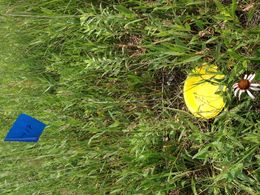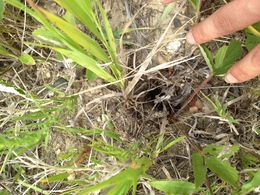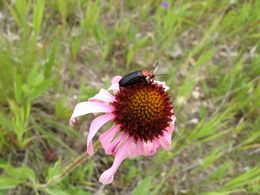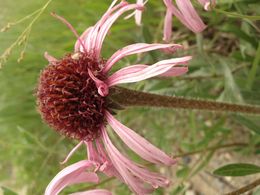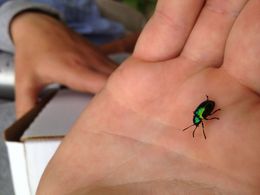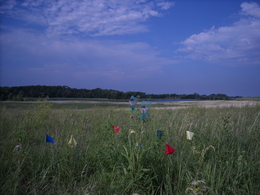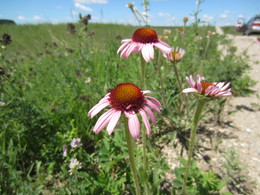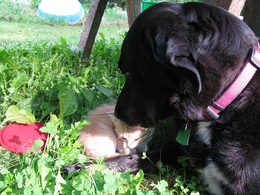|
|
We, well, most of us, headed out to the Hjelm House to assess phenology in the Common Garden. Those that were not there were out in the remnants/preserves working on individual projects. Shona went out at Hegg Lake to perform some angustifolia and pallida crosses. Maria also went out to Hegg where she looked at dicanthelium. Once Common Garden phenology was finished, Andrew worked on his pollinator efficiency experiment. Kelly and Lydia headed out to a few remnants to do phenology and assess within-remnant crosses, respectively. Lydia had a few crosses that were entirely successful as well as some ambiguous results.

The afternoon was fairly relaxing and comprised of a trip into Alexandria, laundry, frisbee, and playing with Felix, the new kitten.
Despite the heat and humidity, Friday was yet another productive field day for Team Echinacea.
This morning everyone worked on their individual projects. Since my pitfall traps are ready to go, Greg and I placed pollinator traps on different prairie remnants. Pollinator traps are these nifty –and apparently hard to come by– yellow bowls that you fill with soapy water. Traveling from remnant to remnant, we also discovered that there’s a giant hole where the landfill prairie remnant used to be…

Later this morning, equipped with buckets as chairs, Greg and I headed up to one of the hills around Hegg Lake to observe some large soil-nesting bees. After an hour of watching, we saw two bees land in different holes, but no bees emerge. We’re not sure whether these bees are solitary or eusocial.
I also scored some pictures of the arthropod life on Echinacea heads.


  
Here is the “fuzzy” Echinacea head from the Kittleson roadside. Echinacea styles typically shrivel when successfully pollinated and persist when unpollinated or pollinated with incompatible pollen. In the case of this poor plant, the “fuzziness” is caused by all of the styles persisting, indicating that this plant hasn’t been successfully pollinated yet.
 
After lunch, the team trekked out to the common garden (C1) to measure Echinacea that had been planted in previous years. Measuring each plant year after year gives us a sense of the fitness of the individuals. We recorded things like the number of basal rosettes, number of basal leaves, as well as the length of the longest leaf, insect presence, among a slew of other characteristics.
Greg and I took off a bit early from measuring to go collect the pollinators from the traps we set out earlier in the morning. Also, Shona made a beetle friend! We’re still trying to figure out what exactly this little guy is and I’ll post it once we figure it out.

I realize that most of these pictures are sideways and I don’t know how to fix it at the moment. All of them were rotated the right way when I uploaded them…go figure.

This summer I’m building off of Nicholas’ work with E. angustifolia and E. pallida hybridization. I uploaded my proposal last week, but I’ve already learned a lot since then.
First of all, after first thinking that I should be collecting pollen, painting bracts, observing styles and crossing all on the same day, Stuart pointed out that it would be better to do crosses one day and everything else the next. It makes things go faster, and it is also easier to tell which bracts were painted when. With that in mind I made a bare bones materials and protocol sheet to keep myself organized:
angustifolia_pallidaCrossingProtocol.doc
It worked wonderfully for a few days, when most of the heads were flowering and I didn’t have to keep track of which plant had been sufficiently crossed and which needed more, and then it started getting a little complicated, especially when Gretel found another pallida head to add in….
Talking to Stuart and Gretel a few days into my crossing I found out that I had been crossing in a less efficient manner than I could have been. I had been trying to fit all of my potential crosses onto each head, every time I crossed. This meant that I would have five or six different colors to paint, each with three or four bracts, and that I would have to do the same the next time to have enough styles. Then I had to look back and forth between data sheets to see whether style shriveling was consistent. What I’ve switched to now (for the most part) I think is closer to what Stuart had in mind. Now I try to paint six bracts for each cross, and just alternate crosses. For example, I’ll do three of the crosses one day and three the next time if there are 18 anthers on a head.
Today, Gretel came out to Hegg Lake to help paint bracts, and combined with less switching between colors, it took us about half as long as it has been for the painting and observing.
It also seems like most of my plants will be done flowering soon. A few have already finished, and a few of the plants with large or multiple heads have already been crossed with every possible cross.

Here are two of my Echinacea heads at Hegg Lake, bagged to exclude pollinators and thoroughly flagged to help protect them from being mowed.
This morning we split our time between work on individual projects and observing phenology in the common garden and at Hegg Lake.
I spent my morning at Hegg Lake again crossing the E angustifolia and E paliida that I painted yesterday. And when Gretel arrived to do phenology at Hegg Lake and pick me up she found a new E pallida in its first day of flowering!
Andrew observed his first pollinators on Echinacea with a video camera, and even managed to catch a few for specimens, as well as working on phenology in the common garden.
Kelly went out to observe phenology in some of her remnants, and is starting to see many flowering heads.
Lydia went to make her first compatibility crosses, but had a few problems with cross contamination so will have to make more crosses tomorrow.
Jill and Katherine GPSed the pitfall traps they had set up earlier at Staffanson and Nessman as well as helping with phenology.
Maria had another early morning at Hegg Lake learning about Dichanthelium pollination and found out that Dichanthelium has two sets of anthers.
Greg Dierson also arrived this morning, and will be joining us for a while.
After a long lunch Gretel and Stewart explained the procedure for measuring plants in the common garden, and we completed the first few hours of what is going to be a lot of searching for and measuring plants. Of course, we also got to stand outside and enjoy the day, which thankfully wasn’t quite as hot or humid as yesterday.
With the help of Andrew and Kelly, I finished setting up all of my pitfall traps for my ant survey today–a grand total of 12 5x30m plots and 144 pitfall traps! I started on Monday with Katherine, setting up Nessman, the smallest of my sites. We quickly learned that digging holes with the soil core sampler is much more efficient when we have some sort of sharp object to dislodge soil from the sampler & that having a dibbler to pre-form holes speeds up the process.



On Tuesday Katherine, Lydia, Kelly, and I set up the plots on East Elk Lake Road, Northwest Landfill, and North Northwest Landfill. Today Andrew, Kelly, and I braved the ticks out in Staffanson prairie preserve, knocking out the final 4 plots, 2 on the east unburned side and 2 on the west burned side.



To give the disturbed areas some time to settle, I’m leaving my traps capped until next week, after which I’ll collect specimens weekly and get cracking on ID-ing. For more details about why I’m doing what I’m doing, see my proposal.
Also, a brief protocol for setting up and collecting from my pitfall traps is below:
Pitfall Trap Procedure.pdf
Here’s my summer project proposal explaining my work with the ants in the prairie. I still need to tighten up the methods a bit, so keep an eye out for updated versions!
JG_REU Project Proposal 2012.pdf
This summer I’m going to continue with Amber Z’s phenology research from last year. I’ve added on two new sites: North Northwest of Landfill and Around Landfill. I started taking data on June 18th when there were only a couple of plants beginning to flower, but now, many more plants have started flowering and a couple are even close to finishing!
Kelly’s Flowering Phenology Project Proposal.doc
The Echinacea are blooming!

And all of the team members are busy working on their individual projects! Here’s what we did today:
-Maria woke up at the crack of dawn to observe the Dicanthelium at Hegg Lake and even try out some crosses!
-Shona was also at Hegg Lake this morning painting the heads of 9 different Echinacea for her pallida-angustifolia hybrid research.
-Lydia also painted Echinacea heads today. She spent the morning at the Around Landfill site working with Gretel to prepare for her compatibility crosses.
-Jill and Kelly tag-teamed this morning to combine Kelly’s work on phenology at Around Landfill, Northwest of Landfill, and North Northwest of Landfill with Jill’s ant survey plot preparation at Staffanson Prairie Preserve.
-Andrew perfected his bee-catching skills this morning in preparation for his pollinator observation research. He caught over two dozen bees right in Hjelm House yard!
-Katherine was also hard at work in C1 this morning. She’s making great progress on her aphid addition/exclusion experiment.
-Stuart plugged away at map making in Hjelm House this morning. He’s using data from a GPS device in order to make maps of the locations of experimental plants in the remnants. They’re incredibly useful when you’re trying to keep track of over 50 plants in the same remnant.
Work proceeded as usual this afternoon despite a brief thundershower. In addition to continued individual project work, Lydia and Shona trimmed the rest of the Ash in the Common Garden. Here’s to a productive Wednesday!
As a continuation of Katie Koch’s experiment in the summer of 2010, I am investigating the pollinator efficiency of bees that visit Echinacea.Project Proposal AK 2012.pdf
Here are the day’s events:
When we arrived at work this morning we came upon a poignant scene. The Wagenius’ family dog, Roxie, had was nurturing an abandoned kitten:

I’m happy to say the poor creature has found a home with Kelly and her parents. Thanks to her loving care (and Roxie’s), it is now purring and mewling with gusto.
Once the kitty situation was resolved, we moved on to more serious business. Shona, Maria, Kelly, and Lydia spent the morning working on their individual projects while the rest of us assessed flowering phenology in two experimental plots (C1 and C2).
A lot of work goes into maintaining an experimental plot. In order to keep C1 from being overgrown by woody plants, several of us spent the afternoon trimming ash trees and sumac. The rest of us made progress on our individual projects. Thanks to help from Kelly and Lydia, Jill and I succeeded in setting up ant traps for all but one of our field sites. I’ll post more about that later.
|
|


